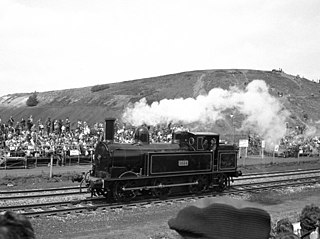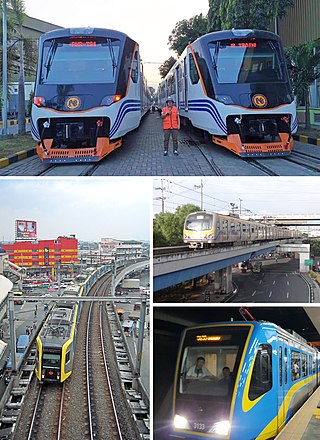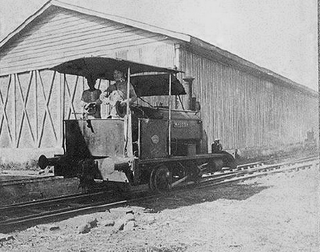
The Philippine National Railways (PNR) is a state-owned railway company in the Philippines which operates one commuter rail service between Laguna and Quezon, and local services between Sipocot, Naga and Legazpi in the Bicol Region. It is an attached agency of the Department of Transportation.

Dübs & Co. was a locomotive manufacturer in Glasgow, Scotland, founded by Henry Dübs in 1863 and based at the Queens Park Works in Polmadie. In 1903 it amalgamated with two other Glasgow locomotive manufacturers to create the North British Locomotive Company.

Under the Whyte notation for the classification of steam locomotives, 0-6-2 represents the wheel arrangement of no leading wheels, six powered and coupled driving wheels on three axles and two trailing wheels on one axle.

Rail transportation in the Philippines is currently used mostly to transport passengers within Metro Manila and provinces of Laguna and Quezon, as well as a commuter service in the Bicol Region. Freight transport services once operated in the country, but these services were halted. However, there are plans to restore old freight services and build new lines. From a peak of 1,100 kilometers (680 mi), the country currently has a railway footprint of 533.14 kilometers (331.28 mi), of which only 129.85 kilometers (80.69 mi) are operational as of 2024, including all the urban rail lines. World War II, natural calamities, underspending, and neglect have all contributed to the decline of the Philippine railway network. In the 2019 Global Competitiveness Report, the Philippines has the lowest efficiency score among other Asian countries in terms of efficiency of train services, receiving a score of 2.4, and ranking 86th out of 101 countries globally. The government is currently expanding the railway network up to 1,900 kilometers (1,200 mi) by 2022 through numerous projects.

A mixed train or mixed consist is a train that contains both passenger and freight cars or wagons. Although common in the early days of railways, by the 20th century they were largely confined to branch lines with little traffic. Typically, service was slower, because mixed trains usually involved the shunting (switching) of rolling stock at stops along the way. However, some earlier passenger expresses, which also hauled time-sensitive freight in covered goods wagons (boxcars), would now be termed mixed trains. Generally, toward the end of the mixed train era, shunting at intermediate stops had significantly diminished. Most railway passenger and freight services are now administered separately.

Ferrocarriles de Cuba (FCC) or Ferrocarriles Nacionales de Cuba, provides passenger and freight services for Cuba.

Tutuban station is the central railway terminus of the Philippine National Railways (PNR) network located in the city of Manila, Philippines.

The tranvía was a streetcar system that served Manila and its surrounding cities during the early years of the 20th century.

The Manila Railroad 300 class of 1914 were cog locomotives used for the Antipolo line and the Aringay–Baguio branch of the PNR North Main Line. These were also known in the railroad's mechanical department as the R class.

The Manila Railway Manila class of 1885 were a class of five 0-4-0 saddle tank locomotives built by the British manufacturer Hunslet Engine Company, and were the first locomotive class in Philippine service. Three of these locomotives were built as light-duty switchers for the Manila Tranvia system while two more were built for the Ferrocarril de Manila a Dagupan inter-city rail services in the 1890s.

The Manila Railroad 45 class of 1919 were twenty-one 4-6-0Ten-wheeler steam locomotives. Twenty locomotives were built by American light duty locomotive manufacturer H.K. Porter, Inc. between 1919 and 1921 for the Manila Railroad Company (MRR). The so-called Porters were the most successful steam locomotive class in Philippine service. They carried express trains for passengers as well as short-range maintenance trains for 70 years and served both the MRR and its successor, the Philippine National Railways. However, like all tender engines from the Manila Railroad era, the last locomotive was scrapped in the 1990s without a single unit preserved.

The Manila Railroad 200 class were 2-10-2 Santa Fe steam locomotives operated by the Manila Railroad Company (MRR), predecessor of the Philippine National Railways. They were built alongside the 4-8-2 Mountain-type 170 class by the American Locomotive Company at its Brooks facility between 1921 and 1922. During its service at the MRR, it carried heavy freight trains on the South Main Line between Manila and the Bicol Region.
The Manila Railroad 160 class[a] of 1914 was a class of four 2-6-0+0-6-2 Double Mogul-type Kitson-Meyer locomotives. This particular class was the only type of articulated locomotive used by both the Manila Railway/Railroad Company, which were the predecessors to the Philippine National Railways. The class was introduced in 1914 and was originally intended for mixed traffic services on the Antipolo line. After that line's closure in 1917, the locomotives were transferred to the South Main Line to serve in Lucena, Quezon, and Pagsanjan, Laguna. All were withdrawn in 1925, shortly after the arrival of their replacements such as the Manila Railroad 200 class.

The Manila Railway 100 class of 1906 was a class of five 4-4-2 Atlantic type steam locomotives built by the North British Locomotive Company for the Manila Railway Company, a predecessor of the Philippine National Railways. They were the flagship locomotives of the Manila Railway from the late 1900s to the 1910s and were the first class of tender locomotives to operate in the Philippines. They hauled the Baguio Special, an express service between Manila and Baguio via Damortis station in Rosario, La Union.

The PNR North Main Line is one of the two trunk lines of the Philippine National Railways in the island of Luzon, the other being the PNR South Main Line. The line during its maximum extent led to various cities and municipalities in Central Luzon and the Ilocos Region.

The Manila Railway 70 class of 1908 was a class of at least twenty-two 0-6-2 side and well-tank locomotives built by the North British Locomotive Company. These locomotives were first put into service on a mainline during the late 1900s and early 1910s by the Manila Railway Company. Their primary purpose was to support the growing network and replace the aging Dagupan class engines. They were used on all the lines of the Manila Railway and its succeeding incarnation, the Manila Railroad. Over time, some locomotives were either scrapped or given to sugarcane plantations after being withdrawn. The last unit, No. 79, remained in service with the Pampanga Sugar Development Company as late as 1989.

The Manila Railroad Company (MRR) was a Filipino state-owned enterprise responsible for the management and operation of rail transport in the island of Luzon. It was originally established by an Englishman named Edmund Sykes as the private Manila Railway Co., Ltd. on June 1, 1887. British engineer Horace L. Higgins was then assigned at the helm in Manila as its first general manager. On July 7, 1906, a separate private entity named the Manila Railroad Company of New Jersey was established. The two companies continued to own the Luzon railroad network until February 4, 1916 when the Insular Government acquired both companies and absorbed them into the new Manila Railroad.
The Manila Railway 37 class, later classified as the Manila Railroad D class, were eight 4-6-0 Ten-wheeler steam locomotives built by Kerr, Stuart and Company.

















